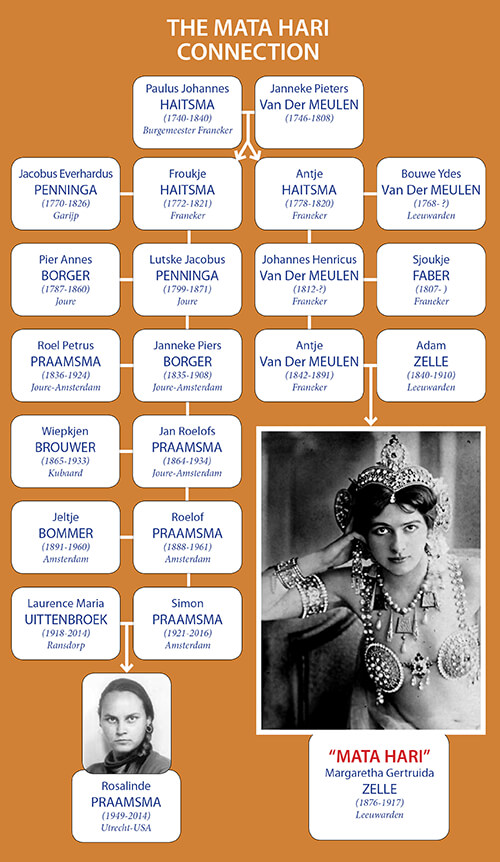Mata Hari
Margaretha Geertruida ZELLE ("Mata Hari")
Margaretha Zelle (1876-1917) was born in Leeuwarden, in Friesland, the daughter of a hat shop owner whose investments in the oil industry made him wealthy enough to temporarily provide his family with a lavish lifestyle, including exclusive schools for his four children. In 1889 her father went bankrupt, her parents divorced, and Margaretha went to live first with her godfather in Sneek and later with her uncle in The Hague.
In 1895 she married Captain Rudolf MacLeod (1856–1928), an upper class colonial army captain living the Dutch East Indies (now Indonesia), after answering his advertisement for a wife. This match gave her financial security and an entry into high Dutch circles. They moved to Java and had two children, Norman(1897) and Jeanne (1898). However, the marriage was doomed, MacLeod being a drunkard and a wife-beater who kept a concubine. As an escape from her unhappiness Margaretha studied the Indonesian traditions and joined a dance company, at which time she adopted the name Mata Hari ("eye of the day" in Malay). In 1899 both of her children fell violently ill from syphilis. Jeanne survived but Norman died. The family moved back to the Netherlands where the couple separated in 1902. A custody battle ensued and Jeanne went first to live with her mother and later with her father, Margaretha not having the resources to fight back. Jeanne died at 21, possibly from complications relating to syphilis.
In 1903, Margaretha--using the name Lady MacLeod--moved to Paris where she made ends meet by performing as a circus horse rider and posing as an artist's model. By 1905, posing as Mata Hari, a Javanese princess of priestly Hindu birth, she won fame as an exotic dancer, following the successful debut of her act at the Musée Guimet. In addition, she became the mistress of the Musée's founder, millionaire Lyon industrialist Émile Étienne Guimet. Provocative photos of her from this period, nude or nearly so, were obtained by MacLeod who used them to strengthen his custody case.
Mata Hari's seductive style of dancing garnered wide acclaim, most notably the segment of her act where she progressively shed her clothing until she wore only a jeweled bra and head and arm ornaments, though she wore a flesh-colored body stocking throughout her performances. Her style elevated exotic dance to a respectable status. Her free-spirited attitude made her popular and enabled her to mingle in wealthy circles, where it was assumed the claims to her colorful origins were genuine.
By 1910 numerous imitators started to appear, and critics began denouncing the features of her dazzling act as cheap exhibitionism lacking in artistic merit. Serious cultural institutions condemned her as a dancer who did not know how to dance, and her career went into decline. She performed her last show on 13 March 1915.
Older and heavier, she now became known as a successful courtesan famous for her eroticism and sensuality rather than her beauty, enjoying liaisons with high-ranking military officers, politicians, and other powerful men. But as World War I approached, she began to be seen as a wanton and promiscuous woman, a dangerous seductress. The Netherlands remained neutral, so with her Dutch passport she was able to cross international borders freely and her movements attracted attention.
In 1916 Margaretha became involved with a 25-year-old Russian pilot, Captain Vadim Maslov, serving with the French. In the summer of 1916 he was shot down by the Germans, losing sight in both eyes. Normally she would not be allowed near the front, but agents from the Deuxième Bureau told her that she could only see her lover if she agreed to spy on Germany. The plan was that she would obtain military secrets by seducing the Crown Prince, for whom she had previously performed as Mata Hari.
Unaware that the Crown Prince was more of a playboy that the great warrior he had been had been promoted as by Prussian propaganda, the Deuxième Bureau offered Margaretha a million francs to provide them with good intelligence about German plans. Zelle's contact with the Deuxième Bureau was Captain Georges Ladoux, who was later to emerge as one of her principal accusers.
Arrested by the British during her first mission in 1916, her alibis were airtight and she was released but kept under close surveillance. The French became suspicious because she had lovers on both sides and was being paid by the Germans to “keep them company.”
Arrested and interrogated by the Secret Service when entering France, Mata Hari confessed to being a German spy. In the trial that followed she was condemned as “one of the greatest spies of the century, responsible for the deaths of tens of thousands of soldiers,” and in 1917 executed before a firing squad. Claiming her innocence to the end, Mata Hari never disclosed who she worked for and the files on her case are still closed.

